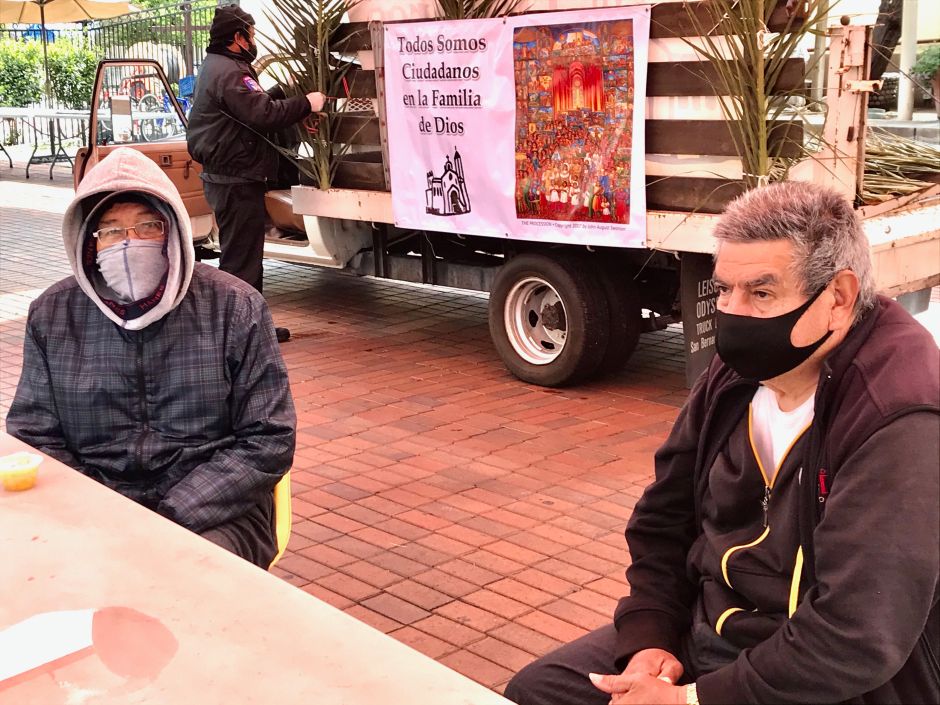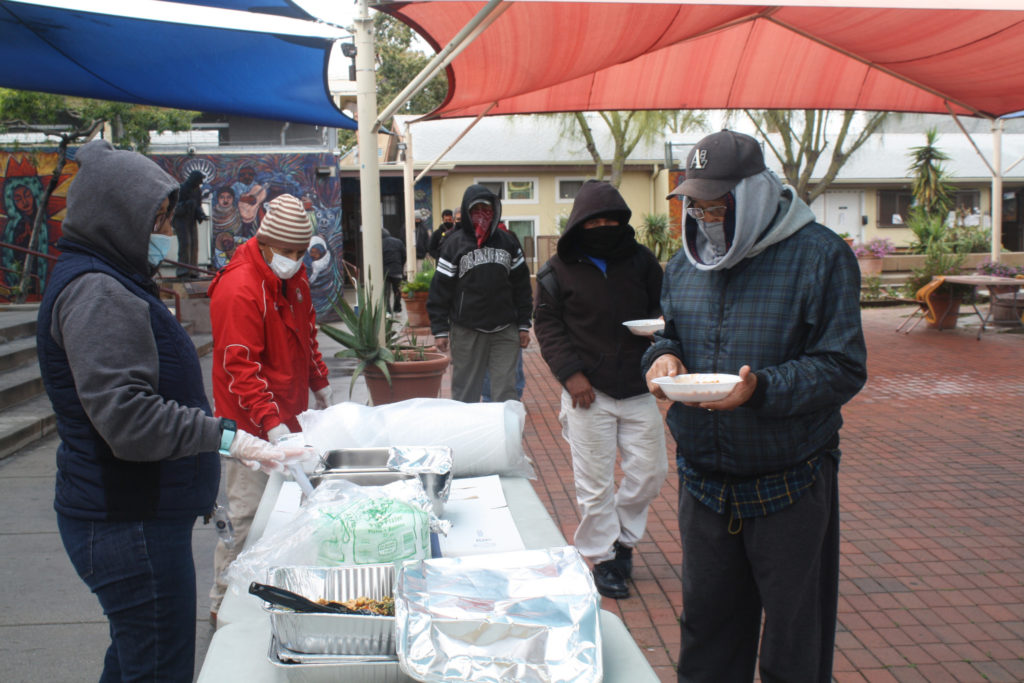by Agustin Durán. To read the original Spanish-language article in La Opinión, click here. (Para leer este artículo en español, haga clic aquí.)

Juan, age 71, and Gerardo, 65, in Los Angeles. (Photo credit: Agustín Durán)
The first thing Gerado recommends to young people so that they do not end up on the street is to learn a trade with which they can maintain themselves their whole life. He did not have one and at 55, when he lost his job, nobody wanted to hire him.
Today, at 65 years of age, he lives on tips from an East Los Angeles supermarket and bounces around from shelter to shelter to have one less expense.
Gerado is originally from Los Reyes, Michoacán, where his wife and son currently live. He wants to fix their legal status and bring them to the United States. But if he is not lucky, he would like to get a formal job with a decent salary to buy a house in Mexico and stop renting.
He considers his age to be his biggest obstacle. He says that physically he can still do a lot of things, but once companies realize he has reached retirement age, he is hardly considered for the job.
He seems a little tired, but the thought of his family encourages him to keep on going. For now, due to the pandemic, he stays at the Dolores Mission Pastoral Project shelter in East Los Angeles. Gerardo is looking forward to everything going back to normal to start earning some money and sending it to his family.
María Aranda, PhD, associate professor of Social Work and Gerontology, said that unfortunately there is a lot of discrimination against the elderly. Stereotypes that say a person over 50 neither responds nor can keep up the same as younger workers add to the stigma against older adults.
However, she stresses that there are studies that indicate that a person over 50 is more responsible and tends to miss less days of work than a younger person. Furthermore, from experience, their judgments in important decisions are usually more accurate.
According to AARP. every day about 10,000 people reach the age of 65. Among them are a large number of Latino immigrants who came to the United States after 1970.
Considering the large number of people who are reaching old age, a report published by researchers from the University of Pennsylvania, the University of California, Los Angeles and the Universities of New York and Boston indicate that by 2030, the number of people over 55 who live on the streets will almost triple.
The study, published in 2019, highlights that in 10 years, the number of indigent people will grow from approximately 40,000 to 106,000. This will increase the costs of health care and the need for shelters.
Juan, 71 and also homeless, lives in the same Proyecto Pastoral shelter. He says he feels more fortunate since thanks to his 27 years of work in a company, he receives income from his social security. Although, the amount he receives is not enough to pay rent in Los Angeles. He has decided to move back and live in Mexico.
“I do not have any other alternative. Here, with what I earn, it would only be enough for me to pay the rent,” says the immigrant. Juan is assured that as soon as they lift the stay at home order, the first thing he will do is fix some immigration documents and return to Mexico.
“It is impossible to live in Los Angeles on a pension,” he says.

Gerardo, 65, deeply misses his family in Mexico. (Photo credit: Agustín Durán)
In Los Angeles
Juan and Gerardo are part of the 60 homeless who live in the at the Pastoral shelter. Dolores Mission. They are also part of the group that has grown the most on the streets and shelters in Los Angeles.
According to the latest data released by Los Angeles Homeless Services Authority (LAHSA), in 2019 there were 13,606 people over 55 who lived on the streets or in a shelter. That represented an increase of 7% compared to 2018. In this group, 3,654 people were Latinos. Of these, 508 lived in a shelter and 3,146 on the streets. This figure represented a 22% increase over the previous year.
Raquel Roman, director of the Proyecto Pastoral program, explained why the number of elderly homeless, mostly immigrants, has increased in the center.
“The most common reason that people who come to the shelter inform us is the increase in rent and gentrification of neighborhoods,” says Román. “Most of them live on a fixed income that the government sends them and it is not much, so an increase of up to 300% in rent is too much for them.”
Chris Estrada of the Los Angeles Center for Community Law and Action (LACCLA) said that in the two years that he has worked with the anti-eviction organization, he has seen this group of seniors grow. He underlines that this phenomenon is not new since it is a trend that has come for many years.
“Currently 60% of our members are elderly,” he said. “Either they are afraid of being evicted due to the situation they are experiencing or they have already lost their home and are currently living with relatives, in a shelter, their vehicles or on the streets.”
This group, says Estrada, is one of the most vulnerable to current problems: due to high rent costs, unemployment and now the COVID-19. Furthermore, he explains, it is easier to abuse them, because they are not informed; they do not know how to defend themselves, and most of them live on a fixed income and have no other option.
Data from the organization reveals that of the 200 members living on the street or who currently live in a shelter or in another place that is not a conventional home, 95% are Latino.
Estrada stresses that unfortunately the problem of housing and homelessness was already a dramatic crisis, but the pandemic intensified it. Cases of people at risk of losing their home can only be expected to increase. On May 1, a strike of 12,000 tenants began a movement at the state and national level that called for the absolution of rents and mortgages during the health crisis. The goal is to prevent further evictions.
According to LACCLA, 50,000 eviction lawsuits were filed in Los Angeles County in 2018, and the numbers for 2019 are estimated to be very similar.
The article “Aging on the Streets: America’s Growing Older Homeless Population,” published by Simmons University in 2016, indicates that the problem of homelessness of the elderly began in the 1980s when economic tension increased with stagnant wages, the disappearance of pension plans and higher housing costs. But more recently, the problem increased with the 2008 economic crisis when large numbers of older adults lost their jobs and were less likely to find new ones.
To Counter the Problem
Jean Galiana, coordinator of the LAHSA Senior System, said the organization is dedicated to housing older adults who are homeless. The COVID-19 crisis has redoubled efforts, due to the increased vulnerability of the elderly to serious complications of the virus.
He added that, during the current crisis, 80% of the organization’s resources focus on individuals who are at risk of contracting COVID 19. Most of these individuals are elders.
Galiana explained that the organization and its associates have set a goal of giving housing to 15,000 individuals living on the street with the Room Key Project in hotels and to include services that go beyond housing. “Our goal is to enable them, not only to survive in these months, but to prosper and become stronger and healthier and then move to housing after the crisis,” Galiana explained.
Considering that the elderly is one of the groups at highest risk of contracting COVID-19, Dr. Aranda said that it is very easy for an outbreak of infection to arise among people living on the street. It is a group with less care or access to health care.
In addition, many of them do not trust the government or suffer from another type of illness, so a contagion of the coronavirus could be fatal.
Currently, under 5,000 people who are homeless live on LA’s Skid Row, of the 36,000 in the city and 59,000 in the county. It is precisely there where a center for testing for the Coronavirus has already been installed.
Aranda explained that, unfortunately, these types of emergencies, such as the pandemic that is experienced worldwide, have strongly affected the economy. As in 2008, many people have lost their jobs. This means that people like Gerardo and others over 50 will have problems returning to their work, which in turn could generate a new wave of people who become homeless.
“It is important that the government intervenes with measures that protect and help this group to move forward. Otherwise, we will see an increase in this homeless population for many years to come,” said the Professor.
Regarding Latino Groups
Professor Aranda said that destitution among elderly Latinos has unfortunately become relevant lately, but so far there are no specific studies in academic reading that explain this phenomenon seriously, adding: “This is very worrying.”
Agustin Durán, Metro Editor of La Opinión in Los Angeles, wrote this article in Spanish and also translated it into English with the support of a journalism fellowship from The Gerontological Society of America, Journalists Network on Generations and the Silver Century Foundation.
The opinions expressed in this article are those of the author and do not necessarily reflect those of the Diverse Elders Coalition.
